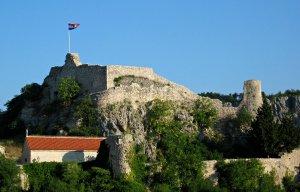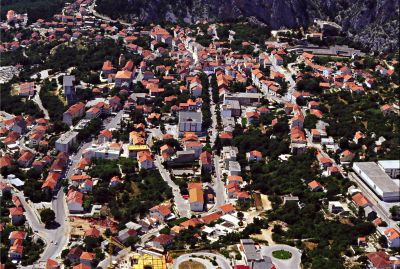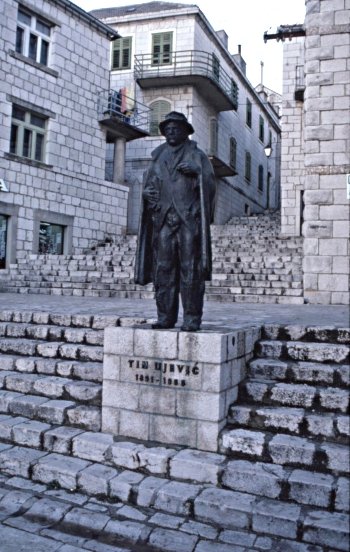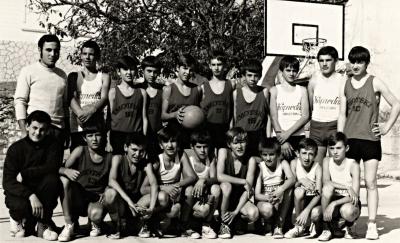| |
|
Imotski
is more than a millenium old town, first mentioned as Imota, Zupania ta
Emotha, with it's fortress as a center in the Byzantine Emperor
Constantine Porphyrogenitus chronicle, "De administrando imperio,"
written between 948-952 A.C. During its history Imotski was occupied
for many years by a foreign force starting with Turks in 1493, Italians
in 1717, then Austrians in 1797, Napoleon's France between 1806-1813
who build much spoken of Napoleon road, and last Austrians ending with
Frantz Joseph as a ruler who has left impact on Imotski architecture by
building its Court House, County House, High School, and the Modro
Jezero trails.
|

|
The nature, starting with Modro Jezero,
Red Lake, and Biokovo mountain is breathtaking.
 Imotski
used to consist of four quarters: Bazana, Jezero, Pazar, and
Djirada, as enabled on the interactive map on the left. Bazana is the oldest part of the town next
to Topana fortress.
Jezero is the best preserved part of the old town.
It has the county administrative offices. Pazar has overtaken Jezero as a part that has
the most shops and cafés.
Djirada is mostly residential quarter that always had the Post office.
To those we need to add much younger Gaj at the eastern Imotski
edge and and the New Settlement at the southwestern edge.
On the north Bage and Jažići settlements and
Glavina on the southwest are slowly merging with Imotski. Imotski
used to consist of four quarters: Bazana, Jezero, Pazar, and
Djirada, as enabled on the interactive map on the left. Bazana is the oldest part of the town next
to Topana fortress.
Jezero is the best preserved part of the old town.
It has the county administrative offices. Pazar has overtaken Jezero as a part that has
the most shops and cafés.
Djirada is mostly residential quarter that always had the Post office.
To those we need to add much younger Gaj at the eastern Imotski
edge and and the New Settlement at the southwestern edge.
On the north Bage and Jažići settlements and
Glavina on the southwest are slowly merging with Imotski.
Here is a visual
map of Imotski:

|
|
1 Modro Jezero |
|
|
2 Jezero quarter where
the administrative buildings are |
|
|
3 Fortress Topana with
Bazana quarter beneath it |
|
|
4 Saint Frane Church
|
|
|
5 Djirada quarter
where the old Post Office was located |
|
|
6 Pazar quarter with
its Stjepan Radić square |
|
|
|
7 Gaj |
|
|
8 Old Truccolo
mills |
|
|
9 New Bus station
|
|
|
10 Imotski graveyard
|
|
|
11 Bage settlement
|
|
|
12 New Settlement
|
|
Move
the magnifier
over the image to
see details. |
 |
In addition to its beautiful nature
Imotski has a long tradition of cultural organizations and happenings.
There is a rich folk art tradition around the town in nearby villages
that has inspired actor Ilija Zovko to start "Imotska Sila." Imotski
has hosted "Imotska Sila" every Summer for the past twenty five years
bringing many renowned performers and troupes. Well known is its Brass
Orchestra and a younger generation of classical music performers.
Imotski High School "Mate Ujević," the name was given in recognition of
the well known Croatian encyclopedist, was one of the best high schools
in Croatia in sixties, producing many well know scientists, men of
arts, and sportsmen. Imotski is a birth town of writer Dinko Štambak.
Another well known Imotski County son, the poet Tin Ujević has a
stature on the Stjepan Radić Square.
|
Soccer was almost always the most popular
sport in Imotski. The names of Braco Ćosić and Zvonimir Boban are known
to the generations of local sports fans. The latter one was a captain
of the Croatian team that took a bronze medal in the World Cup in
France, 1998. The nearby villages were the main centers of soccer
activities before the construction of the Jelavić Dolac stadium when
they decided to join forces and to field one strong soccer club from
Imotski. But, it was basketball, introduced by Aljoša Cici Rako in mid
sixties that took the center stage in the town. Early seventies were
the best years for the Imotski basketball club after Milivoj Zupčić
Blavor joined the club after a transfer from Zadar. Women handball and
men bowling had their good years, as well as several oriental martial
arts. Very active are the Mountaineering
Club Imotski and diving club "Crveno Jezero" Imotski.

|
|



 Imotski
used to consist of four quarters:
Imotski
used to consist of four quarters: 